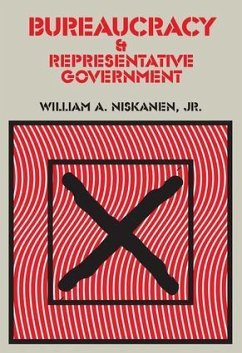Jr. Niskanen
Bureaucracy and Representative Government
Jr. Niskanen
Bureaucracy and Representative Government
- Gebundenes Buch
- Merkliste
- Auf die Merkliste
- Bewerten Bewerten
- Teilen
- Produkt teilen
- Produkterinnerung
- Produkterinnerung
This is the first book to develop a formal theory of supply by bureaus
Andere Kunden interessierten sich auch für
![The Promise of Representative Bureaucracy The Promise of Representative Bureaucracy]() Sally Coleman SeldenThe Promise of Representative Bureaucracy171,99 €
Sally Coleman SeldenThe Promise of Representative Bureaucracy171,99 €![The EU High Representative The EU High Representative]() Niklas HelwigThe EU High Representative91,99 €
Niklas HelwigThe EU High Representative91,99 €![Routledge Handbook on the European Union and International Institutions Routledge Handbook on the European Union and International Institutions]() Routledge Handbook on the European Union and International Institutions49,99 €
Routledge Handbook on the European Union and International Institutions49,99 €![Ethics Management for Public and Nonprofit Managers Ethics Management for Public and Nonprofit Managers]() Donald C MenzelEthics Management for Public and Nonprofit Managers227,99 €
Donald C MenzelEthics Management for Public and Nonprofit Managers227,99 €![Direct Democracy Or Representative Government? Dispelling The Populist Myth Direct Democracy Or Representative Government? Dispelling The Populist Myth]() John HaskellDirect Democracy Or Representative Government? Dispelling The Populist Myth171,99 €
John HaskellDirect Democracy Or Representative Government? Dispelling The Populist Myth171,99 €![Public Sector Strategy Design Public Sector Strategy Design]() David E. McNabbPublic Sector Strategy Design167,99 €
David E. McNabbPublic Sector Strategy Design167,99 €![Rethinking the Welfare State Rethinking the Welfare State]() Ronald J. DanielsRethinking the Welfare State178,99 €
Ronald J. DanielsRethinking the Welfare State178,99 €-
-
-
Produktdetails
- Produktdetails
- Verlag: Routledge
- Seitenzahl: 252
- Erscheinungstermin: 20. September 2017
- Englisch
- Abmessung: 235mm x 157mm x 18mm
- Gewicht: 521g
- ISBN-13: 9781138519909
- ISBN-10: 1138519901
- Artikelnr.: 50497484
- Herstellerkennzeichnung
- Libri GmbH
- Europaallee 1
- 36244 Bad Hersfeld
- gpsr@libri.de
- Verlag: Routledge
- Seitenzahl: 252
- Erscheinungstermin: 20. September 2017
- Englisch
- Abmessung: 235mm x 157mm x 18mm
- Gewicht: 521g
- ISBN-13: 9781138519909
- ISBN-10: 1138519901
- Artikelnr.: 50497484
- Herstellerkennzeichnung
- Libri GmbH
- Europaallee 1
- 36244 Bad Hersfeld
- gpsr@libri.de
Jr. Niskanen
I: Introduction
1: Introduction
II: Critical Elements of a Theory of Supply by Bureaus
2: Characteristics of Bureaus
3: Bureaus and Their Environment
4: The Bureaucrat's Maximand
III: The Basic Model
5: Budget and Output Behavior
6: Production Behavior
7: Comparison of Organizational Forms
8: Effects of Changes in Demand and Cost Conditions
IV: Variations on the Basic Model
9: Nonprofit Organizations
10: The "Mixed" Bureau
11: The Multi-Service Bureau
12: Effects of the Time-Distribution of Expenditures
V: The Government Market for a Bureau's Services
13: The Behavior of Collective Organizations
14: A Model of the Review Process in Representative Government
15: Bureaucratic Behavior in a Competitive Environment
16: An Aggregative Model of Public Services in the United States
VI: The Alternatives
17: The Basis for Normative Judgments
18: Bureaucratic Alternatives
19: Market Alternatives
20: Political Alternatives
VII: Conclusion
21: A Summary Agenda
1: Introduction
II: Critical Elements of a Theory of Supply by Bureaus
2: Characteristics of Bureaus
3: Bureaus and Their Environment
4: The Bureaucrat's Maximand
III: The Basic Model
5: Budget and Output Behavior
6: Production Behavior
7: Comparison of Organizational Forms
8: Effects of Changes in Demand and Cost Conditions
IV: Variations on the Basic Model
9: Nonprofit Organizations
10: The "Mixed" Bureau
11: The Multi-Service Bureau
12: Effects of the Time-Distribution of Expenditures
V: The Government Market for a Bureau's Services
13: The Behavior of Collective Organizations
14: A Model of the Review Process in Representative Government
15: Bureaucratic Behavior in a Competitive Environment
16: An Aggregative Model of Public Services in the United States
VI: The Alternatives
17: The Basis for Normative Judgments
18: Bureaucratic Alternatives
19: Market Alternatives
20: Political Alternatives
VII: Conclusion
21: A Summary Agenda
I: Introduction; 1: Introduction; II: Critical Elements of a Theory of Supply by Bureaus; 2: Characteristics of Bureaus; 3: Bureaus and Their Environment; 4: The Bureaucrat's Maximand; III: The Basic Model; 5: Budget and Output Behavior; 6: Production Behavior; 7: Comparison of Organizational Forms; 8: Effects of Changes in Demand and Cost Conditions; IV: Variations on the Basic Model; 9: Nonprofit Organizations; 10: The "Mixed" Bureau; 11: The Multi-Service Bureau; 12: Effects of the Time-Distribution of Expenditures; V: The Government Market for a Bureau's Services; 13: The Behavior of Collective Organizations; 14: A Model of the Review Process in Representative Government; 15: Bureaucratic Behavior in a Competitive Environment; 16: An Aggregative Model of Public Services in the United States; VI: The Alternatives; 17: The Basis for Normative Judgments; 18: Bureaucratic Alternatives; 19: Market Alternatives; 20: Political Alternatives; VII: Conclusion; 21: A Summary Agenda
I: Introduction
1: Introduction
II: Critical Elements of a Theory of Supply by Bureaus
2: Characteristics of Bureaus
3: Bureaus and Their Environment
4: The Bureaucrat's Maximand
III: The Basic Model
5: Budget and Output Behavior
6: Production Behavior
7: Comparison of Organizational Forms
8: Effects of Changes in Demand and Cost Conditions
IV: Variations on the Basic Model
9: Nonprofit Organizations
10: The "Mixed" Bureau
11: The Multi-Service Bureau
12: Effects of the Time-Distribution of Expenditures
V: The Government Market for a Bureau's Services
13: The Behavior of Collective Organizations
14: A Model of the Review Process in Representative Government
15: Bureaucratic Behavior in a Competitive Environment
16: An Aggregative Model of Public Services in the United States
VI: The Alternatives
17: The Basis for Normative Judgments
18: Bureaucratic Alternatives
19: Market Alternatives
20: Political Alternatives
VII: Conclusion
21: A Summary Agenda
1: Introduction
II: Critical Elements of a Theory of Supply by Bureaus
2: Characteristics of Bureaus
3: Bureaus and Their Environment
4: The Bureaucrat's Maximand
III: The Basic Model
5: Budget and Output Behavior
6: Production Behavior
7: Comparison of Organizational Forms
8: Effects of Changes in Demand and Cost Conditions
IV: Variations on the Basic Model
9: Nonprofit Organizations
10: The "Mixed" Bureau
11: The Multi-Service Bureau
12: Effects of the Time-Distribution of Expenditures
V: The Government Market for a Bureau's Services
13: The Behavior of Collective Organizations
14: A Model of the Review Process in Representative Government
15: Bureaucratic Behavior in a Competitive Environment
16: An Aggregative Model of Public Services in the United States
VI: The Alternatives
17: The Basis for Normative Judgments
18: Bureaucratic Alternatives
19: Market Alternatives
20: Political Alternatives
VII: Conclusion
21: A Summary Agenda
I: Introduction; 1: Introduction; II: Critical Elements of a Theory of Supply by Bureaus; 2: Characteristics of Bureaus; 3: Bureaus and Their Environment; 4: The Bureaucrat's Maximand; III: The Basic Model; 5: Budget and Output Behavior; 6: Production Behavior; 7: Comparison of Organizational Forms; 8: Effects of Changes in Demand and Cost Conditions; IV: Variations on the Basic Model; 9: Nonprofit Organizations; 10: The "Mixed" Bureau; 11: The Multi-Service Bureau; 12: Effects of the Time-Distribution of Expenditures; V: The Government Market for a Bureau's Services; 13: The Behavior of Collective Organizations; 14: A Model of the Review Process in Representative Government; 15: Bureaucratic Behavior in a Competitive Environment; 16: An Aggregative Model of Public Services in the United States; VI: The Alternatives; 17: The Basis for Normative Judgments; 18: Bureaucratic Alternatives; 19: Market Alternatives; 20: Political Alternatives; VII: Conclusion; 21: A Summary Agenda









